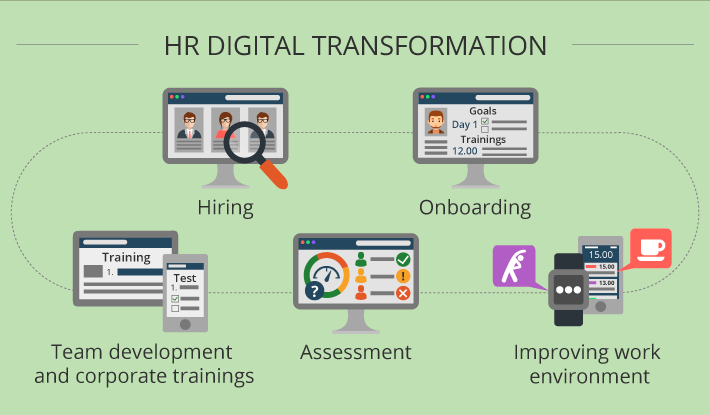HR digital transformation: on the way to continuous workforce improvement
According to a recent report by Accenture and SuccessFactors, a SAP company, HR operations need to be more agile than ever to keep up with today's workforce. In this respect, automating HR processes is not enough. Traditional approaches don't work the way they used to, and it's necessary to revise outdated employee management architectures and find more effective alternatives to traditional methods of managing human resources.
The solution is digital transformation in HR exploring and implementing new ways of working with specialized apps that revolutionize HR management and employee experience at every stage of the employee lifecycle.

Hiring
Hiring the right people is more than just filling vacancies. Companies need the right team members to set up new locations, develop new markets and implement new business models. Rising competition for high-skilled candidates generates the necessity for HR managers to enhance their talent acquisition capabilities: increase the quality and speed of hiring.
Even if you get the most from your website, public job boards and social networks (for example, LinkedIn), far better results are possible with technology-driven tools for hiring:
- Online interviewing and interview management improves recruitment efficiency and increases its speed when many candidates should be interviewed.
- A digital competency library can become a handy tool to quickly develop accurate job descriptions and hold competency-based interviews.
- Using CRM-like approach to active head-hunting: creating expanded candidate profiles with additional professional details from a variety of sources (for example, online assessments), nurturing candidates, matching previously rejected candidates to new vacancies.
Such tools transform the way HR departments find suitable talents, communicate with them and hire them. On top of that, technology-driven approach to hiring becomes an exciting experience for both HR managers and candidates and supports a company's employment brand.
Onboarding
To employ suitable candidates is just the first step to building a competitive talent pool newbies should be introduced to their responsibilities and blend into the team. HR Digital Transformation uncovers new ways to organize onboarding and communicating with newbies to make this period smoother and faster than ever before.
One way to ensure successful onboarding is to use a personal employee page that contains a detailed onboarding plan with the goals for the adaptation period (for example, introductory training sessions and test tasks).
The progress in introductory training and assignments is not the only side to control during onboarding: another important thing is an employee's satisfaction and comfort level in a new team. For this purpose, a company can use the tools to gather and analyze newbies' feedback, for example, online questionnaires. It's even better if feedback becomes visualized to display statistics in a more digestible way. Moreover, this data can show the quality and effectiveness of the corporate onboarding program and point at its gaps.
Team development and corporate trainings
Even if you hire the best employees, in a dynamic working environment their skills can become obsolete within several months. This makes the need for both rapid and continuous learning more important than ever, and companies need to re-strategize the way they educate their employees.
Digital transformation in HR empowers companies to go beyond traditional approaches to learning and, apart from improving the trainings, make employees more involved in education.
Engaging in learning may be difficult for the staff because of a heavy workload - they just cannot find enough time. To promote corporate education and target-based development of competencies, companies can use mobile learning apps that make learning more accessible, interesting and effective.
Also, traditional training sessions can be enhanced with new features: interactive tests and quizzes, virtual reality, video conferencing and online sessions for those who cannot participate.
Apart from studying new things, reviewing is also important - partially it happens in everyday working activities, and additional revisions can be conducted with apps (let it be quizzes, for example).
IT solutions also modify the approaches to corporate education and prompt at new smart learning paths such as:
- Engaged learning: entertainment approach to training, gamification, involving augmented reality.
- Contextual learning: information given at the training is linked to practical context: participants solve themed challenges in real-world situations. Employees get immediate results and stay motivated to learn.
These are only a part of the educational opportunities provided by digital solutions. Still, they can become great supplements to help your talents remain competitive.
Assessment
Real-time employee analytics becomes crucial for organizations to see how effective they recruit from the perspective of value and cost, select underperformers for trainings (or firing) and promising employees for promotion, identify whether employees are given right salaries and salary increases and more.
Traditional ways of stuff assessment, for example, managers' feedback, can be rather subjective, inconsistent and time-consuming. Here's just a couple of examples of how IT solutions can upgrade stuff productivity evaluation:
- CRM can become a great tool to assess the sales reps' efficiency in interaction with customers.
- Automated competency tests and intranet surveys can become reliable ways to receive and process data about employees' skills. Automatically generated reports can provide a detailed view of employees' data and ensure continuous and transparent competency assessment.
- Feedback templates help managers give quick but comprehensive feedback on performance.
- A frequent practice for evaluating management activities is to ask subordinates how well they understand the goals set by the manager. For such cases, an intranet integrated with survey services can automatically initiate template-based surveys.
IT tools cannot replace humans in evaluating employees' productivity, but digital solutions can transform this process and empower managers to increase the quality and speed of assessment.
Improving work environment
Due to high recruitment costs, investing in employee wellness seem a reasonable thing to do to retain employees and create a friendly and productive work environment. Technologies have strong potential to improve employee wellness, control work-life balance and drive performance.
To be productive the whole day, employees need to recharge. Some companies introduce wearable devices to enable employees to create and manage fitness challenges. Enterprises can inject new life into everyday working routine with mobile apps that give healthy tips, fitness reminders and coffee-break notifications and more.
All this makes work less monotonous, improves work communication and makes employees become enthusiastic about their work and more loyal to employers.
To sum it up
To win the best talents, retain them and help them remain competitive, companies need to go beyond automating traditional HR approaches because these approaches don't answer present-day talent management challenges and don't meet the expectations of the present-day tech-savvy workforce.
With well-chosen IT solutions, a company can transform and enhance everyday HR activities in various aspects:
- Solutions for hiring reduce time and costs on hiring and increase its effectiveness.
- IT-driven onboarding support helps newbies feel at home and unlock their potential.
- Regular training sessions and competency assessments enable employees to develop their professional skills and knowledge.
- Interactive features (for example, healthy tips in smartphones) enliven office work and make your people more motivated and productive.
Of course, the best option is to gather all HR-related tools in a centralized HRM system. But if a standalone multifunctional application seems too expensive or a company is not sure about its effectiveness, introducing additional features to the systems already in use will be a good way to test digital innovations and enter the path of HR digital transformation.
If you still don't know how to begin, digital transformation consulting services can help to work out the best approach to HR transformation and invest in the right things.

